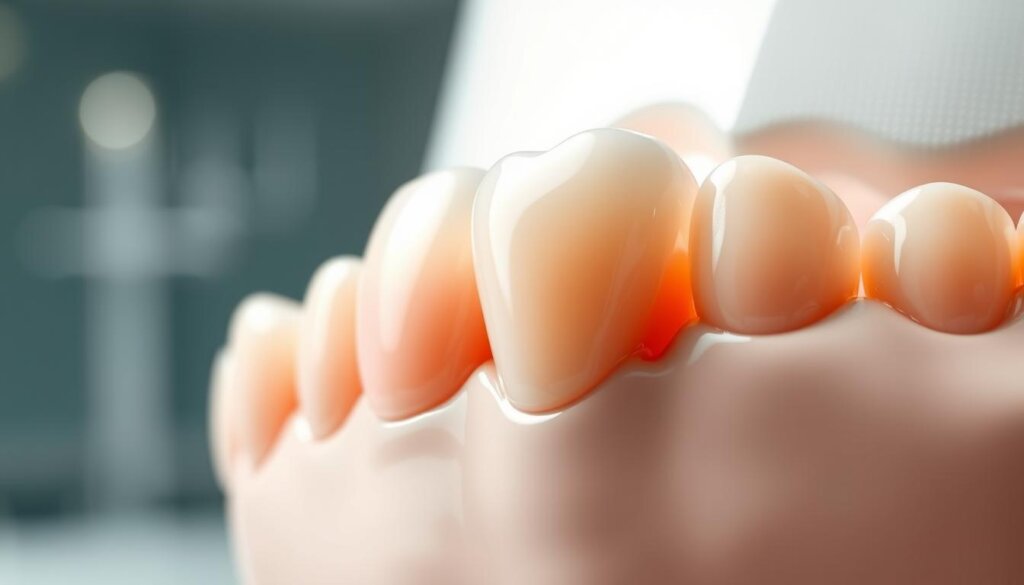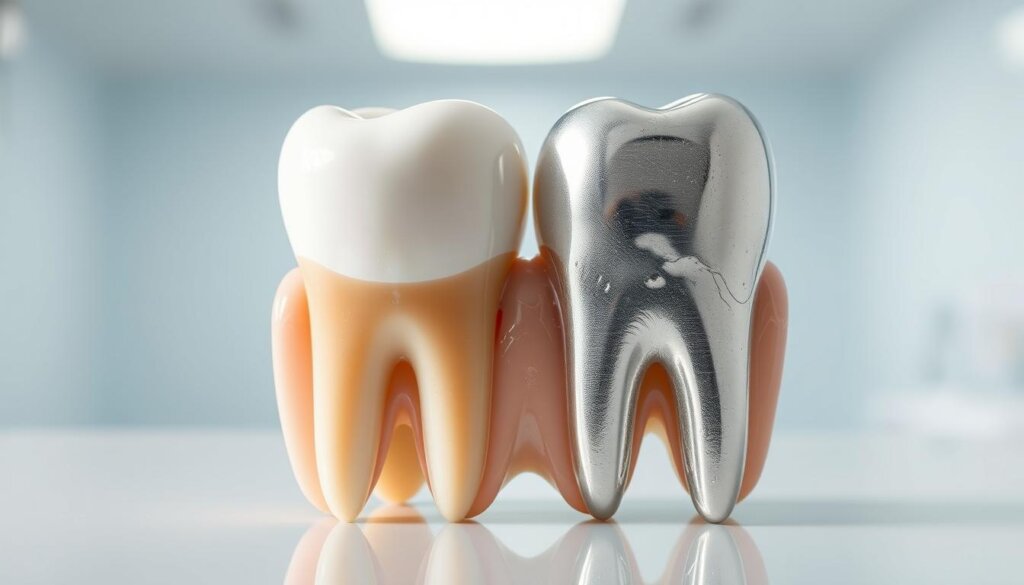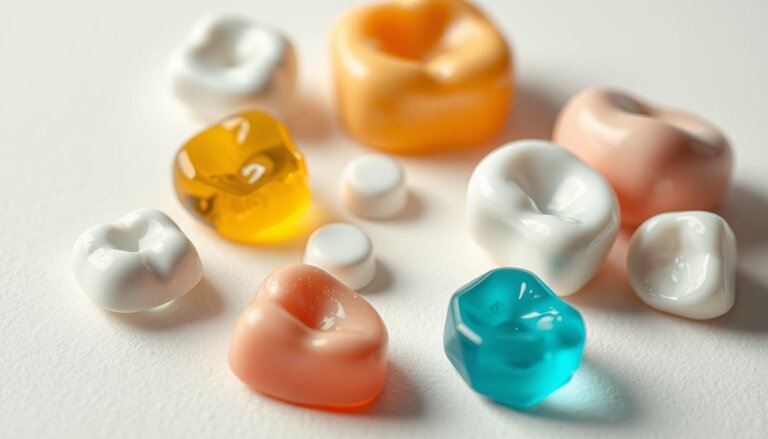What are Composite Fillings Used For?
Today, almost 2.3 billion people worldwide have problems with their permanent teeth. Composite fillings have become key in fixing these issues. They’re not just for filling holes in the teeth caused by decay. Now, they also fix chips and cracks. When we explore what composite fillings do, we see their wide use. They fill decayed spots, fix teeth worn down by grinding, and repair minor flaws. This strengthens the teeth with a material that looks and works like natural teeth.
Composite fillings mix plastic resins with fine glass particles. This blend sticks well to tooth enamel, forming a strong bond. This makes them look good and work well as a fix for cavities. Fixing teeth with composite fillings needs less drilling than old methods. This is good for mending chips and breaks in teeth too. Composite fillings offer a quick and barely noticeable way to fix these problems.
Key Takeaways
- Composite fillings play a crucial role beyond treating cavities and are found to be effective for repairing various dental issues.
- They are constructed from a mix of plastic resin and powdered glass, which blends seamlessly with natural teeth.
- Considered less invasive, composite fillings bond quickly and directly to the tooth, often preserving more of the natural structure.
- The use of composite fillings for chips and bruxism-related damage is expanding in restorative dentistry.
- In Spokane, WA and elsewhere, composite fillings have become the restorative preference for a natural appearance and compatibility.
Overview of Composite Fillings
In the world of dentistry today, composite dental fillings are key for fixing and beautifying teeth. They’re not just essential for filling cavities. They’re also widely chosen for making teeth look better, making cosmetic composite fillings very popular with people wanting a nicer smile.
What Are Composite Fillings?
Composite fillings play a big part in composite filling treatment. They’re a mix of resin and tiny glass particles. This mix makes a strong material that matches your teeth’s natural color well. So, the fillings blend in with your teeth nicely.
Materials Used in Composite Fillings
The stuff in composite dental fillings includes a plastic resin base and stuff like silica. These are used because they look like real teeth and stick to your tooth well. This means the fix can last a long time.
Advantages of Using Composite Fillings
Choosing cosmetic composite fillings comes with many pluses, especially how they look. They give a finish that looks like your real teeth. They stick to your tooth in a way that keeps more of your healthy tooth intact. Beyond just filling cavities, they can fix chips or breaks in teeth too.
Common Applications
Composite fillings are a top choice in modern dentistry for several reasons. They are essential for fixing teeth and improving their look.
Composite fillings for cavities work well against tooth decay. They restore a tooth’s strength and function with a strong material. Their tooth-colored material makes sure they blend in, keeping your smile natural.
Composite fillings for chips are commonly used, too. They fix small chips and cracks without being noticed. These fillings are shaped and polished to look just like your real teeth.
Dental restoration with composite fillings does more than just fix cavities and chips. They also rebuild worn-out teeth and can alter the size or color of your teeth. This way, they play a big part in keeping your smile both healthy and beautiful.
Benefits of Composite Fillings
Dental restorations have significantly evolved. Composite fillings are now a top choice for patients and dentists alike. They are known for their aesthetic appeal, strong durability and longevity, and great biocompatibility. These benefits show why composite fillings are favored over traditional amalgam fillings.
Aesthetic Appeal:
Composite fillings match the natural color of teeth perfectly. In contrast to amalgam fillings, which stand out, composites look natural. This is especially good for front teeth, making them an ideal choice.
Durability and Longevity:
Designed for lasting use, composite fillings handle chewing well. They can last many years with the right care. They bond directly to the tooth, reducing the risk of fractures. This bond also requires less tooth to be removed.
Biocompatibility:
Composites are kinder to teeth and less likely to cause sensitivity or allergies. They don’t contain metals like amalgam fillings. For those worried about mercury in fillings, composites are a safer choice.
Composite fillings are an excellent choice for dental restoration. They offer durability, a natural look, and are safer for oral health. Their benefits make them a clear winner in the composite vs. amalgam fillings discussion.
The Procedure for Getting Composite Fillings
The path to better oral health with dental restoration with composite fillings starts early on. It includes carefully planned steps for health benefits and good looks. Patients expect these results from today’s dental care.
Initial Consultation
The first step is the initial consultation in the composite filling procedure. A dental expert checks the patient’s oral health and talks about treatment options. They decide the kind of dental fix needed and choose a composite resin color that matches the teeth well.
The Filling Process
The next step is getting the tooth ready. This means slightly roughening the tooth’s surface for the filling to stick well. The dentist then puts on the composite resin in layers. Each layer is shaped and set with a special light. This method is key because it makes the filling look and feel like real tooth enamel.
Aftercare Tips
After the filling is in place, looking after it is a must. It includes brushing teeth twice a day and flossing. Also, seeing the dentist regularly helps check the filling and fix it if needed.
It’s smart to avoid chewing hard things to keep the filling safe. This makes the filling last longer and keeps it looking good.
With careful planning, expert work, and good aftercare, the composite filling procedure does more than fix teeth. It also makes them look nice. This full approach makes sure every step improves the dental restoration.
Comparing Composite Fillings with Other Filling Types
When thinking about fixing teeth, you often have to choose between composite and amalgam fillings. It’s key to know the differences between composite and others like amalgam, glass ionomer, and resin ionomer. We’ll look into how they match up in looks, function, and how long they last. This discussion aims to clear up what choice is best for different dental issues.
Amalgam Fillings
Used for more than 100 years, amalgam fillings are strong and durable. They’re cheaper and can handle a lot of pressure, which makes them great for back teeth. But, their metal look makes them more visible and less appealing for a natural-looking smile.
Glass Ionomer Fillings
Glass ionomer fillings bond chemically with teeth and release fluoride to stop more decay. They’re not as tough as composite fillings. Yet, they’re a good choice for areas that don’t bear chewing pressure or for kids.
Resin Ionomer Fillings
Like glass ionomer, resin ionomer fillings also release fluoride and stick well to teeth. They look better than glass ionomers but can’t quite match the appearance of composite fillings.
Overall, while all fillings have their benefits, composite fillings stand out. They look the best because they mimic natural teeth very well.
Longevity of Composite Fillings
The durability of composite fillings interests both dentists and patients. It’s about seeking long-lasting dental fixes. Knowing how long composite fillings can last, and how to care for them, matters a lot.
Expected Lifespan
Composite fillings typically last about seven years. With proper care, their life can be much longer.
Factors Affecting Lifespan
- Patient’s oral hygiene habits
- Frequency of dental check-ups
- Nature of dietary choices
- Mechanical stresses such as grinding or clenching
Signs It’s Time for a Replacement
- Visible wear and tear
- Formation of cracks or chips
- Leakage around the filling margins
To keep composite fillings in good shape, see your dentist regularly. And take good care of your mouth. These steps are key for both fillings’ lifespan and your dental health.
Cost Considerations
Knowing the cost of composite fillings and how dental insurance works is crucial for patients. The overall cost is influenced by the case’s complexity and the clinic’s location.
The cost for composite fillings in the U.S. can vary a lot. It often depends on the cavity’s size and how many surfaces need a filling. Here’s a breakdown to help understand:
| Number of Surfaces | Cost Range |
|---|---|
| One Surface | $150 – $250 |
| Two Surfaces | $200 – $300 |
| Three Surfaces | $250 – $350 |
Dental insurance coverage for composite fillings varies. Most plans cover a big part of the cost for basic or preventive care, including fillings. But, the coverage level might change if the filling is for looks or if it’s necessary.
For those without insurance or facing high costs, many dental offices offer payment plans or accept health care credit. This makes cost of composite fillings easier to handle and dental care more open to more people.
Before choosing your treatment, talk to your dentist and insurance provider. This helps you know all about the costs and what’s covered.
Maintenance of Composite Fillings
For composite fillings to last long, taking good care of them is key. This means following the right steps to look after your teeth. Let’s dive into how you can keep your fillings in great shape and keep your smile looking good.
Daily Dental Care
To keep your fillings in top form, daily teeth care is a must. Brush well twice a day with fluoride toothpaste and floss once to get rid of plaque. Using an antiseptic mouthwash also cuts down on bacteria, protecting your fillings and teeth.
Regular Dental Check-Ups
Seeing your dentist often is crucial for your fillings. These visits let dentists check on your fillings and overall mouth health. They can fix any small problems before they get big. Aim to go to the dentist twice a year for the best care.
Foods to Avoid
What you eat matters for your fillings’ lifespan. Stay away from hard foods like ice and candies to avoid chips. Also, cut down on coffee, tea, and red wine to keep your fillings’ color bright. Following these tips will help your dental work last longer.
| Dental Care Tip | Benefit |
|---|---|
| Brushing twice a day | Prevents decay and supports overall health of fillings |
| Flossing daily | Removes debris and reduces risk of fillings deterioration |
| Regular dental check-ups | Ensures early detection and management of potential issues |
| Avoiding hard or staining foods | Preserves structural integrity and appearance of the fillings |
FAQs About Composite Fillings
Dental technology keeps getting better. This brings up questions about composite fillings. People wonder about composite filling safety, how dental filling removal works, and composite staining. Knowing about these parts is important for anyone thinking of getting or who already has composite fillings.
| Question | Answer |
|---|---|
| Are Composite Fillings Safe? | Composite fillings are safe and match well with the body. They’re made of plastic and fine glass. So, they’re no riskier than old-style silver fillings. |
| How Are Composite Fillings Removed? | To remove them, a dentist drills out the filler gently with you under local anesthesia. This common process is safe and aims to keep you comfortable. |
| Can Composite Fillings Stain Over Time? | They are made to fight stains but can change color from food, drinks, or not cleaning well. Regular dentist visits help handle any color changes. |
Getting this info helps patients know what to expect with composite fillings. This helps them make smart choices for their teeth’s health.
Composite Fillings for Children vs Adults
When it comes to composite fillings for children and dental care for adults, different factors must be considered. Each group needs a specific treatment approach to restore their teeth’s health and look. The methods vary greatly between kids and adults.
Pediatric Considerations aim to support the natural growth of a child’s teeth. Kids’ treatments are made to be gentle, keeping their growing teeth and gums in mind. Since a child’s mouth changes over time, composite fillings for children must be flexible. This ensures the fillings support their dental growth without causing problems.
In contrast, Adult Treatment Differences involve fixing more complex dental problems. Adults might need root canals or crowns, focusing on both looks and function. Adult teeth require stronger filling materials due to more wear and tear.
| Pediatric | Adult | |
|---|---|---|
| Focus | Preservation of natural structure | Restoration and aesthetics |
| Treatment Type | Less invasive | Comprehensive |
| Material Considerations | Flexible, accommodating growth | Durable, aesthetic |
The differences in composite fillings for children and dental care for adults show why dentists must change their approach by age. By knowing these distinctions, dental professionals can give everyone the best care, tailored to their dental health needs.
Alternatives to Composite Fillings
While composite fillings are well-liked for fixing teeth, there are other options too. These include dental crowns, inlays and onlays, and sealants. Each has its own benefits and works best for certain dental issues.
Dental Crowns: These caps cover a tooth that’s been harmed by decay or injury. They are perfect for teeth that are very weak, offering strength and protection. Crowns can be made from porcelain, ceramic, or composite resin. This makes them strong, look natural, and match your other teeth.
Inlays and Onlays: These are like partial crowns. They save as much of the healthy tooth as can be saved. They’re used when a tooth is too damaged for a filling but not so much that it needs a full crown. Inlays and onlays are crafted from strong, tooth-colored materials like ceramic or porcelain. They are bonded right onto the damaged part of the tooth.
Sealants: These are put on the molars’ chewing surfaces. Sealants protect the enamel from decay and cavities. They’re mainly for preventing tooth decay, blocking bacteria and acid. Putting on sealants is quick, easy, and helps a lot in fighting dental caries.
Choosing between these options depends on how bad the tooth damage is, your dental history, and what you prefer. Crowns, inlays and onlays, and sealants offer different ways to treat teeth. They ensure everyone has access to dental care that fits their needs.
Technological Advances in Composite Fillings
The realm of dentistry is always getting better because of technological advances in composite fillings. These improvements make dental treatments better in quality. They also make dental restorations last longer and look more appealing. Composite fillings are key to this innovation.
New material science has created better composite materials. They are more like natural tooth enamel in durability and appearance. At the same time, digital dentistry technologies make fillings that perfectly match your tooth. They get the color and shape just right.
| Feature | Traditional Composite Fillings | Advanced Composite Fillings |
|---|---|---|
| Material Composition | Basic resin and filler particles | Improved resin with nano-sized filler particles |
| Customization | Standard color matching | Digital color and shape matching |
| Application Technique | Manual shaping and curing | Digital imaging and 3D printing |
| Longevity | 5-7 years | 10+ years |
These innovations lead to better clinical results. They also make procedures more efficient. This makes patients happier and more comfortable. Dentists now have tools for more precise restorations. These ensure the results last longer and look natural. Combining technological advances with modern digital dentistry shows great progress in dental technology.
Patient Experiences
Learning from those who got composite fillings offers great insight. We see the good points and what worries patients. Many say composite fillings improved their dental health and look.
Common Patient Concerns
But, some folks are worried before they get these fillings. They wonder how long they’ll last and if they’ll have sensitive teeth afterwards. We’ll look into these worries with feedback from patients.
Many patients report elevated satisfaction with the aesthetic appeal of composite fillings, which blend seamlessly with the natural color of their teeth, hence boosting confidence and comfort in their daily interactions.
Yet, some fear the fillings won’t last and may need replacing. Teaching patients proper care and urging regular dental visits can calm these fears. This helps fillings last longer.
| Feedback Theme | Positive Impact | Concerns Addressed |
|---|---|---|
| Visual Appeal | Matches natural tooth color, enhancing smile aesthetics | — |
| Sensitivity Post-Procedure | Temporary and often mild | Information on expected duration and care tips |
| Longevity and Maintenance | Lasts several years with proper care | Guidance on maintenance and regular dental visits |
Dental experts need to talk about these concerns before the process. This way, patients can decide wisely about their dental care.
Myths and Misconceptions
In dentistry, there are many myths about composite fillings that confuse people. It’s very important to correct these wrong ideas. This helps patients understand the real benefits of using composite fillings for their teeth.
Some people think composite fillings aren’t as good or safe as other kinds. We need to tell them the true, proven facts. This helps both patients and dentists know more about these fillings.
| Myth | Fact |
|---|---|
| Composite fillings are not as durable as amalgam fillings. | Modern composite fillings are made to last. They work well for many dental needs over time. |
| Composite fillings are only chosen for their aesthetic appeal. | Looks are just one reason for choosing composite fillings. They also match your teeth well and are less invasive. |
| Composite fillings are unsafe and release harmful chemicals. | Research shows composite fillings are safe. They don’t let out dangerous substances. They’re a good choice for fixing teeth. |
Teaching patients and continuing to learn ourselves is key to getting rid of myths about composite fillings. This leads to better choices and better dental health overall. It makes for better results for everyone.
Trends in Dental Aesthetics
The field of dental medicine is always changing, now focusing more on looks that seem natural and attractive. Trends in dental aesthetics are especially important, with a growing love for fillings that match our teeth’s color. Among these, cosmetic composite fillings are especially popular with both patients and dentists.
People now prefer these composite fillings over old-school metal ones because they look like real teeth. This change makes smiles not just prettier, but it also boosts people’s confidence and comfort.
| Feature | Composite Fillings | Traditional Metal Fillings |
|---|---|---|
| Visual Appeal | High (tooth-colored) | Low (metallic) |
| Aesthetic Integration | Excellent | Poor |
| Popularity Trend | Increasing | Decreasing |
The table clearly shows why cosmetic composite fillings lead the way in trends in dental aesthetics. They are not just about looks; they also meet the new demands of people wanting dental work that is both functional and pretty. This move to modern fillings marks a big shift in what patients expect and what the dental world offers, positioning composite fillings at the heart of cosmetic dentistry.
Conclusion
In summary, composite fillings are crucial in modern dentistry. They do more than just fix cavities. They also repair chipped teeth prettily. Composite fillings perfectly balance looks and durability. They match your natural tooth color, making your smile both beautiful and healthy.
Summary of Uses
Composite fillings are impressively versatile. They not only recreate the natural look of teeth but also keep them strong. Whether fixing cavities or repairing broken teeth, these fillings are durable, safe, and body-friendly. They meet both health and beauty needs of patients.
Importance of Professional Consultation
Seeing a dentist for composite fillings is super important. With so much at stake, you need a dentist’s help to make the right choices. They evaluate your teeth and make a personalized plan.
With expert advice, you get care that fits your unique needs. This ensures strong teeth and a great smile. Realizing the value of these consultations makes composite fillings more effective. It improves your dental health and how your smile looks.




